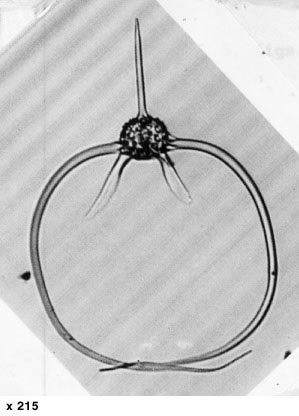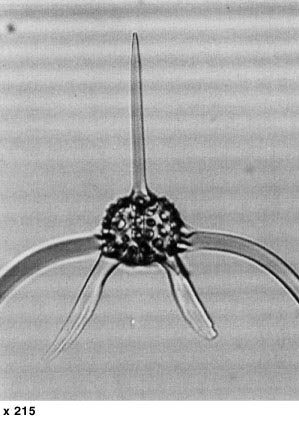 Dorcadospyris
papilio (Riedel)
Dorcadospyris
papilio (Riedel) Dorcadospyris
papilio (Riedel)
Dorcadospyris
papilio (Riedel)Hexaspyris papilio Riedel, 1959, p.294, pl.2, figs.1-2
Dorcadospyris papilio (Riedel), Riedel and Sanfilippo, 1970, p.523, pl.15, fig.5
Shell nut-shaped, tuberculate, thick-walled, with no sagittal stricture externally and with subcircular to circular pores without regular arrangement. Two primary feet more strongly developed than the others, circular in section, initially divergent at approximately 180° or more, then curved semicircularly and thus convergent terminally. Secondary feet three to eight in number (often four), lamellar or subcylindrical, varying in form and disposition. A stout, conical apical horn is present in most specimens. This species is distinguished from all others of the genus by the two primary feet, which are extremely divergent (Riedel, 1959).
Based on 25 specimens. Length of apical horn 65-245 µm; of shell 63-88 µm; of primary feet 260-880 µm; of secondary feet 25-34 µm. Breadth of shell 33-100 µm (Riedel, 1959).
Lattice shell 80-100 µm broad; primary feet 250-900 µm long (Sanfilippo et al., 1985).
 DISTINGUISHING
CHARACTERS
DISTINGUISHING
CHARACTERSDorcadospyris papilio similar to D. riedeli (Moore, 1971, p.739, pl.9, figs.1-3), but with only one pair of primary feet. Similar also to D. pseudopapilio, but with consistently widely divergent primary feet, more than one pair of simple (non-branching) secondary feet, and with no indication of irregular, fine meshwork attached to the secondary feet (Moore, pers. comm., 1992)
At many of its occurrences, this species is accompanied by Dorcadospyris riedeli Moore (1971, p.739, pl.9, figs.1-3), which has four, rather than two, highly arching primary feet (Sanfilippo et al., 1985).
A considerable variety of morphotypes are admitted into this species, which is characterized by the two strong feet initially diverging at 180° or more, thus arching high before curving downward. The small lattice-shell bears also a small to large, conical apical spine, and usually 3-8 secondary feet, which vary from small and subcylindrical to large and lamellar. In some late specimens the lamellar secondary feet are only two in number, distally bifurcate (sometimes doubly) (Sanfilippo et al., 1985).
Dorcadospyris papilio has so far been found only in latest Oligocene and earliest Miocene sediments from low latitudes of the Pacific and Indian Oceans, and in the Caribbean region. Its morphotypic first appearance lies within the Dorcadospyris ateuchus Zone and its morphotypic last appearance lies within the Lychnocanoma elongata Zone.
During the stratigraphic range of this species (latest Oligocene to earliest Miocene) there are many spectacular species of Dorcadospyris, the inter-relationships of which are not yet worked out.
Additional illustrations can be found in Moore, 1971, pl.8, figs.6-7.